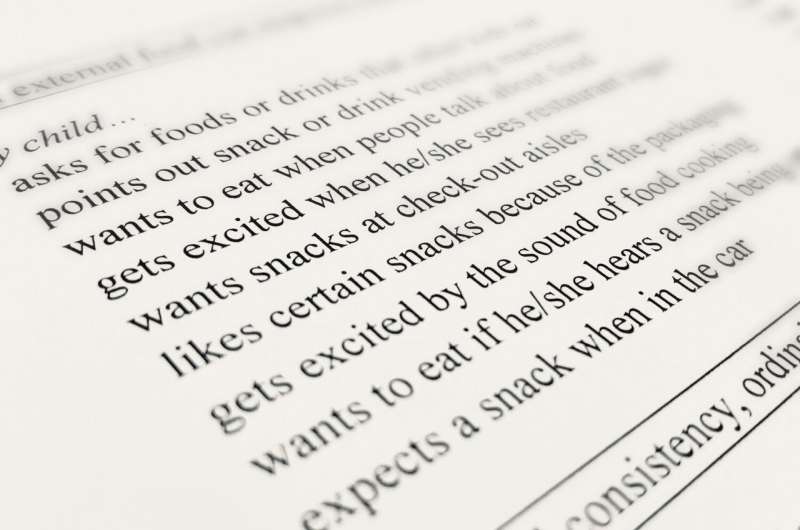A scale to specifically measure responsiveness to external foods is important to understand how aspects of the current obesogenic environment, including exposure to food marketing, may impact a young child's obesity risk. Credit: Norris Cotton Cancer Center
One in four preschool-age children in the U.S. have overweight or obesity, putting them at risk for multiple chronic health problems including cancer. Early and consistent exposure to such food cues may promote conditioned eating, where the cue itself becomes a signal to eat. Children may then learn to eat by exposure to external cues rather than listing to their internal, biological signals of hunger.
Psychometric scales for adults and children ages 7-12 have previously been created to measure responses to external food cues such as desire to eat when walking past a candy store or temptation when food is being prepared. However, to date, no scale exists that specifically addresses responsiveness to external cues, such as visual, environmental or social cues, in contemporary preschool-age children.
A Dartmouth research team led by Jennifer Emond, MS, Ph.D. aimed to extend previous research and develop a brief, parent-reported scale to measure external food cue responsiveness for preschool-age children that could be employed easily in their natural environments. "A scale to specifically measure responsiveness to external foods is important to understand how aspects of the current obesogenic environment, including exposure to food marketing, may impact a young child's obesity risk," says Emond. Their study, "Measurement of external food cue responsiveness in preschool-age children: Preliminary evidence for the use of the external food cue responsiveness scale" is newly published in the journal, Appetite.
The study was conducted in two stages. Eight focus groups of parents of 2-5-year-old children informed an initial pool of 33 items to be included in an external food cue responsiveness scale for preschool-age children. Items included cues such as passing by restaurants, waiting in check-out aisles at grocery stores, seeing others eat, and hearing food wrappers. The items were phrased to enable parents to rate how well each behavior described their own child's behaviors and were scored on a scale of "rarely" to "a lot." These items were then distributed in an online survey to 456 parents recruited nationally via social media. Statistical analyses were applied and the list was reduced to the final nine items comprising the new External Food Cue Responsiveness Scale. Items include branded packaging, product placement, social influence and restaurant logos, which are all aspects of food marketing that impact young children's eating behaviors yet have not been operationalized into an easy-to-administer scale.
Findings suggest that this novel scale effectively captures children's behavioral responsiveness to external food cues and, in particular, cues related to food marketing. The team sought to validate the usefulness of this new scale under free-living conditions by correlating scores with an existing validated scale of food responsivity. As expected, external food cue responsiveness was positively associated with overeating behaviors. Using the common cued-snacking behavior of eating while watching TV, they also found that external food cue responsiveness was greater among children with, versus without, usual TV advertisement exposure.
For the next steps, the research team will assess the validity of the novel scale against laboratory measures of cued-eating in preschool-age children. "This line of research is important for identifying how aspects of a young child's natural environment, including obesogenic features, may impact eating behaviors during this critical stage of development," says Emond.
More information: Travis D. Masterson et al, Measurement of external food cue responsiveness in preschool-age children: Preliminary evidence for the use of the external food cue responsiveness scale, Appetite (2019). DOI: 10.1016/j.appet.2019.04.024
Journal information: Appetite
Provided by Dartmouth-Hitchcock Medical Center























